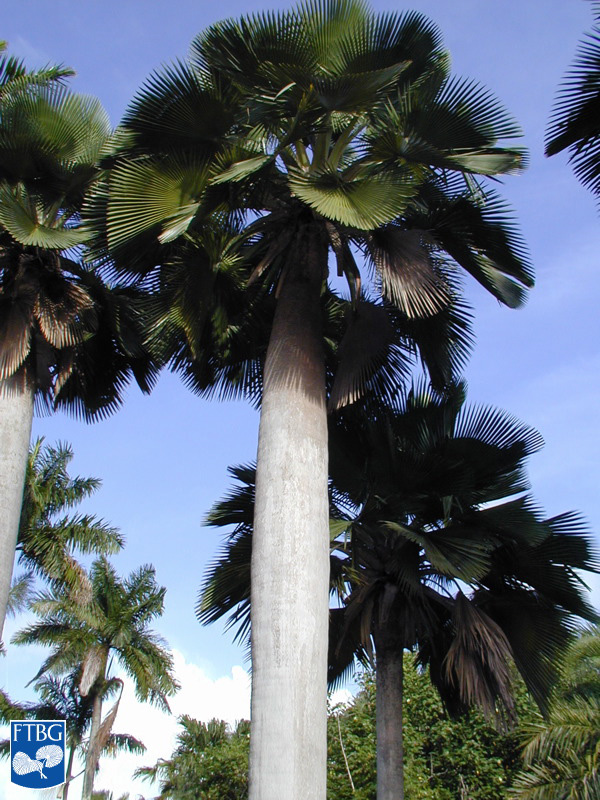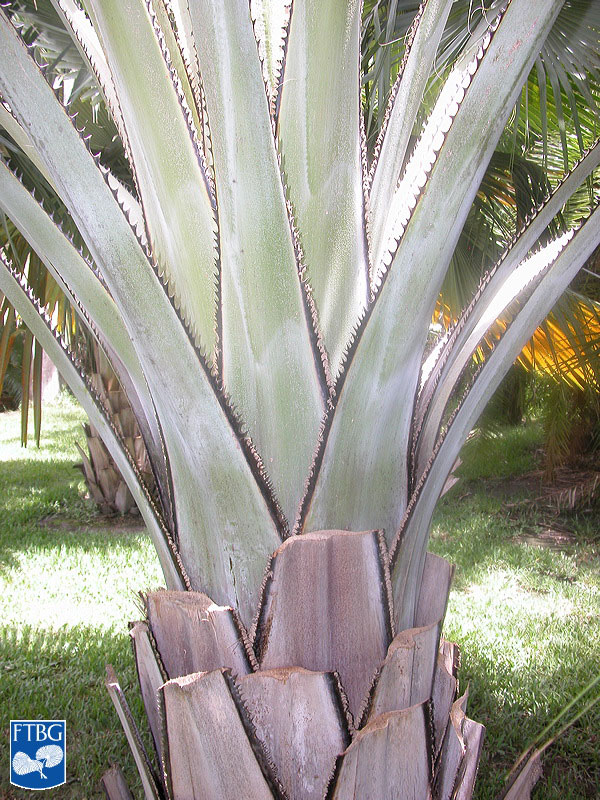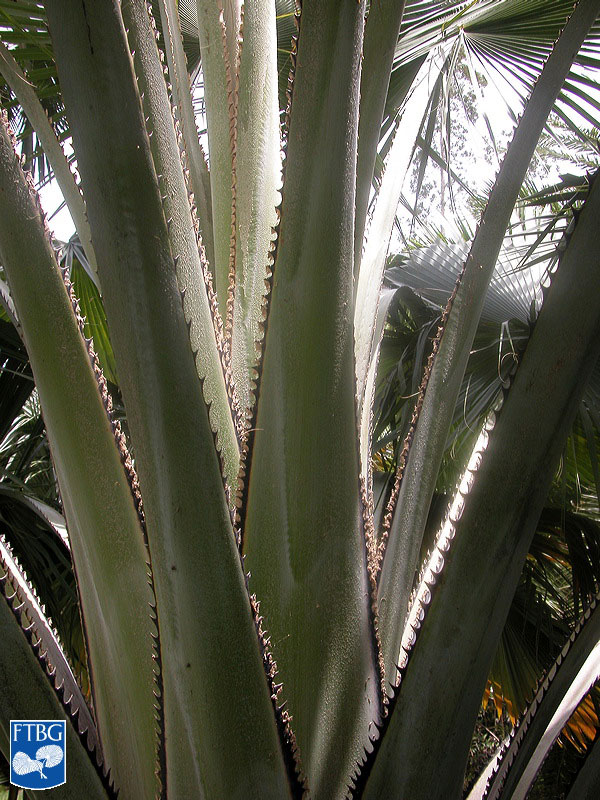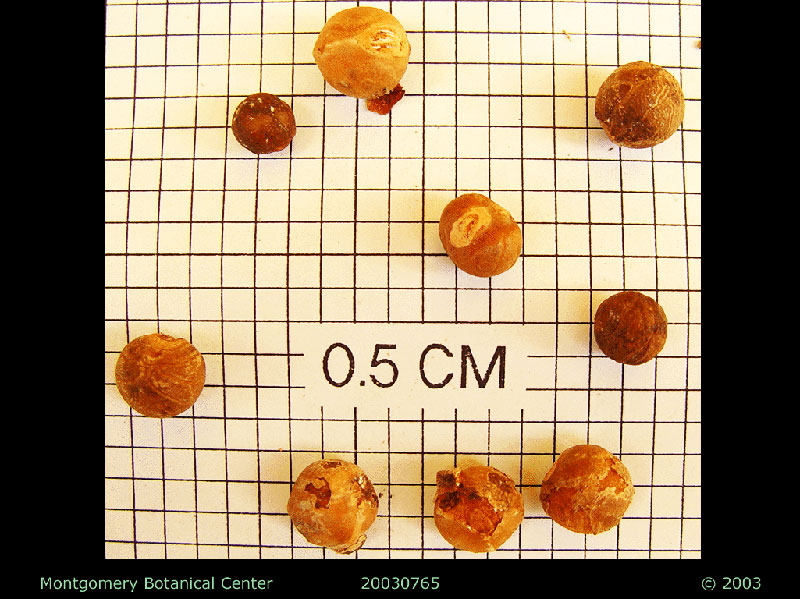Copernicia baileyana
|
Copernicia baileyana habit. Photograph courtesy of Fairchild Tropical Botanical Garden, Guide to Palms http://palmguide.org/index.php |
|
Copernicia baileyana canopy. Photograph courtesy of Fairchild Tropical Botanical Garden, Guide to Palms http://palmguide.org/index.php |
|
Copernicia baileyana petioles. Photograph courtesy of Fairchild Tropical Botanical Garden, Guide to Palms http://palmguide.org/index.php |
|
Copernicia baileyana spines. Photograph courtesy of Fairchild Tropical Botanical Garden, Guide to Palms http://palmguide.org/index.php |
|
Copernicia baileyana leaf blade. Photograph courtesy of Fairchild Tropical Botanical Garden, Guide to Palms http://palmguide.org/index.php |
|
Copernicia baileyana seeds (MBC photo: 20030765-1). Photograph courtesy of Montgomery Botanical Center http://www.montgomerybotanical.org/ |
Common name
bailey fan palm
Description
Stems: Solitary, erect stems, to 20 m tall up to 40 cm in diameter (sometimes swollen to 60 cm near the middle). Stems of younger individuals are covered with persistent leafleaf:
in palms -- the leaf blade (which is usually divided into leaflets or leaf segments), the petiole (or leaf stalk) and the sheath (which forms the attachment of the leaf to the stem)
bases; older palms with smooth, columnar, nearly white stems ringed by faint leafleaf:
in palms -- the leaf blade (which is usually divided into leaflets or leaf segments), the petiole (or leaf stalk) and the sheath (which forms the attachment of the leaf to the stem)
scars. Leaves: Costapalmatecostapalmate:
a fan-shaped leaf with a midrib (costa) extending into the blade, sometimes extending far enough into the blade to cause it to curve (e.g., <em>Sabal palmetto</em>)
, induplicateinduplicate:
Most palm leaflets or leaf segments are obviously folded. If the folds create a V-shape, with the midrib lower than the margins (so that rain might fall "into a valley"), the folding is induplicate.
, with an elongated petiole, a more or less circular blade to 1.5 m across, and stiff leafleaf:
in palms -- the leaf blade (which is usually divided into leaflets or leaf segments), the petiole (or leaf stalk) and the sheath (which forms the attachment of the leaf to the stem)
segments with erect tips. The upper leafleaf:
in palms -- the leaf blade (which is usually divided into leaflets or leaf segments), the petiole (or leaf stalk) and the sheath (which forms the attachment of the leaf to the stem)
surface is green; the undersurface, waxy gray-green; leaftips, bifidbifid:
deeply cleft into two usually equal parts or two-lobed from the apex; for example, palms with bifid leaves or leaflet tips (e.g., <em>Chamaedorea metallica</em> has bifid leaves)
. The petiole is armed with curved teeth and is not split at the base. Flowers and fruits: Inflorescenceinflorescence:
the reproductive structure of a flowering plant, including palms, consisting of flowers and associated bracts
(over 2 m long) often extends beyond the leaves with many feathery branches. The flowers have both male and female parts. Fruits are spherical, up to 18-23 mm long and 18-20 mm in diameter, turning black when ripe.
Diagnostic features
Field: Fan palm with stem to 20 m tall with diameter of 40 cm and swollen bulge to 60 cm; pale columnar stem; leaves with stiff, erect tips.
Lab: Leaf leaf:
in palms -- the leaf blade (which is usually divided into leaflets or leaf segments), the petiole (or leaf stalk) and the sheath (which forms the attachment of the leaf to the stem)
midribs prominent on the underside; transverse veins are not obvious. Pale tan to buff colored wooly tomentumtomentum:
a covering of closely matted or fine hairs on plant leaves
along base of leafleaf:
in palms -- the leaf blade (which is usually divided into leaflets or leaf segments), the petiole (or leaf stalk) and the sheath (which forms the attachment of the leaf to the stem)
blade and midribs.
May be confused with
Other Copernicia species, but the size of the leaves (to 1.5 m) and stiff, erect leafleaf:
in palms -- the leaf blade (which is usually divided into leaflets or leaf segments), the petiole (or leaf stalk) and the sheath (which forms the attachment of the leaf to the stem)
segment tips make it distinctive.
Distribution
Native to Cuba
Additional comments
This magnificent palm is noted for its massive, white, columnar stem, but the juvenile palm begins with an underground stem from which a canopy of a dozen or more leaves appears to grow directly from the soil.
Scientific name
Copernicia baileyana Leon
Family
Arecaceae/Palmae
Synonyms
Copernicia fallaense Leon








